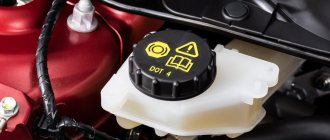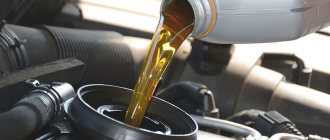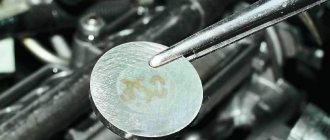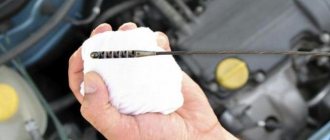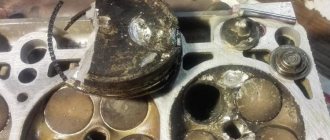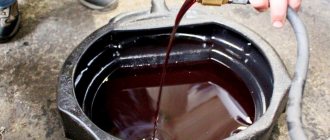A car is a complex technical device, the operation of which depends on the coordinated functioning of all components and mechanisms. If a car's oil consumption is noticeable, a responsible car owner carries out diagnostics of the car, identifying problems in a timely manner, finding the reasons for oil consumption in the engine.
Although some maintenance work can only be performed at a service station, there are also a number of activities that must be carried out independently. In particular, it is important to check the engine oil level from time to time.
Functions performed by motor oil
The main parts of any car are the engine, chassis and body. The source of mechanical energy of the iron horse is its power unit. It can have a different design and run on gasoline, gas or diesel fuel.
In its working chamber, the fuel mixture is burned, after which thermal energy is converted into mechanical energy. To operate, an internal combustion engine requires a number of systems:
- power supply;
- ignition;
- launch;
- lubricants;
- cooling;
- exhaust gas removal.
The operation of the power unit is impossible without a lubrication system, since during operation friction occurs between the motor mechanisms. The presence of an oil film is necessary to minimize wear of parts (it separates them), and to easily start the engine at low temperatures. In addition, motor oil performs a number of other functions:
- maintains optimal thermal conditions;
- does not allow corrosion to occur during engine operation and when the vehicle is parked;
- washes away and removes contaminants (they are maintained in a “suspended” state until the oil is changed): substances formed as a result of combustion of the fuel mixture, wear products, dust, etc.;
- prevents the formation of soot and varnish deposits.
The oil used should not antagonize the sealing elements and catalysts; it is very important that it retains all its performance characteristics until replacement.
When choosing a lubricant to be poured into the engine, you must follow the recommendations of the car manufacturer. It is also extremely important to take into account the engine oil change intervals established for a particular type of equipment.
The service life, reliability and safety of operation of the vehicle directly depend on the quality and characteristics of lubricating fluids used in internal combustion engines.
Permissible oil consumption rates
Periodically checking the engine oil level in the engine using a dipstick often shows the presence of a certain lubricant consumption.
Most often, this should not be a cause for concern, since the car manufacturer itself declares the possibility of losing a certain amount of fluid during operation of the vehicle. Usually it is enough to simply add the missing amount.
How to check the oil level:
- the car must be installed on a flat surface;
- The measurement should be carried out with the engine turned off (after waiting at least 15 minutes);
- Using a dipstick, the volume of oil in the engine is determined: the normal level should be between two marks (MIN and MAX). If it is fixed below the minimum value, you should urgently add fluid.
The level of oil consumption can be influenced by several factors: the type of internal combustion engine, its characteristics, the age of the car, the number of kilometers traveled, and the driver’s driving style.
If the need to add oil occurs frequently, there is reason to think about diagnosing the machine and identifying the causes of increased consumption.
Leakage from the cylinder head gasket
The cylinder head gasket is located on top of the engine. Damage to this gasket can occur in different places, so the lubricant can come out not only outside. If the gasket in the section between the cylinders and the cooling system holes is damaged, then the lubricant will get into the antifreeze, which can be seen by its increased level and color change. Also in this case, the engine smokes when cold. If lubricant gets into the antifreeze, this requires immediate repair, since in this case it is impossible to fully cool the engine. This will lead to overheating and will quickly affect the stability of operation.
How to replace the cylinder head gasket?
Why may the volume of oil poured into the engine decrease?
There are several reasons for engine oil consumption. Firstly, it can evaporate from the surface of cylinders that are operated at very high temperatures.
Secondly, a small amount of oil can enter (due to the lack of absolute tightness of the system) into the combustion chamber, where it ignites along with the incoming fuel mixture.
Important! New engines usually consume virtually no oil. Natural consumption appears as the internal combustion engine wears out.
On average, after traveling 1 thousand km, 100 to 300 ml of liquid can be lost. If the car is operated under load, a consumption of up to 400 ml/1000 km is acceptable. A fairly worn engine, whose mileage exceeds 150,000 km, may lose 500 ml during operation.
Natural consumption rates vary significantly depending on the type of power unit.
What is the oil consumption in a naturally aspirated engine?
Cars with naturally aspirated engines running on gasoline are the most common among all operating vehicles with internal combustion engines. For relatively new power units, the standard lubricant consumption rate is 5...30 ml per 1 thousand kilometers traveled.
Sufficiently worn engines can burn about 100 ml of oil. When operating a car in difficult conditions, you should be prepared to increase the flow rate to 500...600 ml.
Consumption rate for turbocharged engines
More and more cars are appearing on the market equipped with engines that can have from one to three turbines installed. They are characterized by both their gluttony for fuel and their high consumption of lubricating fluids (the more turbines, the higher the losses).
Even new equipment can consume about 80 ml of oil when burning every 100 liters of fuel mixture.
Oil consumption standards for diesel internal combustion engines
If during operation of a diesel engine there is a loss of up to 500 ml of lubricant for every 100 liters of fuel burned, there is no reason to worry. However, if you start spending more, there is a reason to bring the car in for diagnostics.
Extreme vehicle operating conditions also affect oil consumption. High speeds of the power unit, at which an increase in temperature is observed, lead to increased losses. Aggressive driving style or driving in mountainous areas causes more frequent addition of lubricant.
In the winter season, more oil is also consumed than in the warm season. A thick, more viscous lubricant is not able to quickly create the film required for engine operation. Therefore, it is recommended to warm up the engine for several minutes to minimize wear on the rings and cylinder block walls.
Experts advise changing the oil before the onset of cold weather. A new lubricant that has not lost its properties will help the engine operate normally in difficult conditions.
As you can see, engine oil can drain naturally. An increase in its consumption is due to a number of reasons.
Leaking through the crankshaft and camshaft seals
Shaft seals consist of a rubber bushing that can withstand heavy loads, and a plastic compound that contains a spring made of high quality steel. Its function is to ensure long-term elasticity of the omentum. For the seal to work perfectly, the spring must be in the correct position. If it is inserted incorrectly, increased wear of the oil seal is possible and, as a result, the engine consumes oil and smokes. The condition of the camshaft is also important. If there is a large wear on it, the spring will not get into the correct position. With such a leak, oily stains can be seen on the crankcase protection.
Overview of the causes of engine oil consumption
Correctly diagnosing the problem is very important. Otherwise, without fixing the problem, you may soon end up with a failed power unit, the overhaul of which is fraught with large financial losses.
A car owner can easily identify and eliminate a number of problems, but serious causes of engine oil consumption require the intervention of specialists.
Easy to fix troubles
The carelessness of the car owner often leads to problems with engine lubrication.
Incorrectly selected oil
If you are not too responsible in selecting a lubricant and purchasing it at retail outlets with a dubious reputation, you can easily encounter the problem of high oil consumption.
Counterfeit products or goods of poor quality can turn black or burn out literally in liters after 500 km. Even a good quality lubricant, but not having the characteristics required for a particular power unit, can behave unpredictably.
Important! Lubricants must be selected strictly according to the data that is calculated at production and issued by vehicle manufacturers.
Poorly installed oil filter
Often, when changing the oil themselves, inexperienced car owners incorrectly screw on the filter element, which is explained by haste or inability.
As a result, the necessary tightness of the connection is not ensured and oil begins to leak out. The problem can be easily noticed by a puddle of oil under the bottom of the car.
It should be remembered that when replacing a part, it is important to lubricate the O-ring with oil and install the filter with sufficient force. In rare cases, the consumable itself may rupture. This usually happens when purchasing a low-quality product.
Leaking through the cylinder block gasket
Loss of engine oil can be caused by a leak through the cylinder head cover gasket (some car models do not have one - a sealant is used).
It may become deformed over time. Incorrect installation of power bolts (uneven tightening), overheating of the engine, or simply using a poor quality seal also lead to fluid leakage. You can specifically determine such reasons for oil consumption in the engine after inspecting it, for which you just need to open the hood. If there are traces of oil in the gasket area, replace the gasket or re-tighten the BC cap.
Leakage through pan
Over time, the gasket of the power unit pan may also become deformed. In this case, it is enough to simply replace it.
Problems requiring specialist intervention
High oil consumption can also be caused by more serious reasons. To fix the problem, it is often necessary to disassemble the engine.
Worn oil scraper rings
Oil scraper rings located on the engine piston block the access of oil to the combustion chamber. If they overheat or wear down over time, the liquid begins to burn in large quantities, which leads to a noticeable drop in its level.
Exhaust with a bluish tint indicates exactly this problem. To troubleshoot the problem, you can try to use special compounds that eliminate coking of the rings, but most often you need to change the rings.
Deformed seals
Oil seals made of heat-resistant rubber also serve to protect the combustion chamber from engine oil entering it.
Their wear and change in properties contribute to the appearance of carbon deposits on the valves and cylinder walls of the gas distribution system. In this case, oil consumption can reach two liters (per 1 thousand kilometers). As a result, there is a risk of failure of the power unit. There is usually no need to disassemble the engine to replace leaking seals. You just need to remove the block head cover.
Worn walls of the BC
The condition of the cylinder block walls may deteriorate over time due to natural aging or the appearance of defects (such as scratches). The cylinder can also change its shape (the cross-section becomes oval).
As a result, the O-rings do not provide the necessary tightness, which leads to oil leakage. The way out of the situation is:
- or cylinder boring,
- or using less rigid rings (this is not recommended),
- or installing rings with a different geometry that compensates for the change in cylinder shape,
- or replacing the entire unit.
In any case, in this case it is impossible to do without significant financial costs.
Leaking shaft seals
Oil can also escape through the crankshaft and camshaft seals. The edges of these parts may become deformed. This may be due to the influence of time (rubber is not durable) or the use of low quality lubricant.
Oil leakage in this case is not so easy to notice. Replacing the seals will help solve the problem.
As you can see, the main weak point of power units when a lubricant leak occurs is the sealing elements. Most often, the presence of a problem can be determined by visually inspecting the condition of the engine or by looking at oil stains under the bottom of the vehicle.
The main condition when purchasing seals is the purchase of modern materials that are adapted for use in fairly difficult conditions.
Naturally, if the car owner is only able to pull out the dipstick and note a decrease in the oil level, you should not try to independently determine the causes of oil consumption in the engine and eliminate them. Only turning to competent specialists will help you solve the problem quickly and with minimal financial losses.
Abrasion of CPG parts
Excessive wear of the parts of the cylinder-piston group leads to the fact that the machine eats oil, since this increases the gaps on the oil scraper rings in the piston groove. The increased clearance helps pump oil like a pump. The piston, moving down, picks up the lubricant and passes it under itself. The upward movement of the piston helps the oil move upward. This way it is ready to burn. But the combustion of a large amount of lubricant in the pistons leads to coking of the rings. In this case, their functions will be disrupted, which will lead to wear. In this condition, the engine smokes and runs unevenly.
